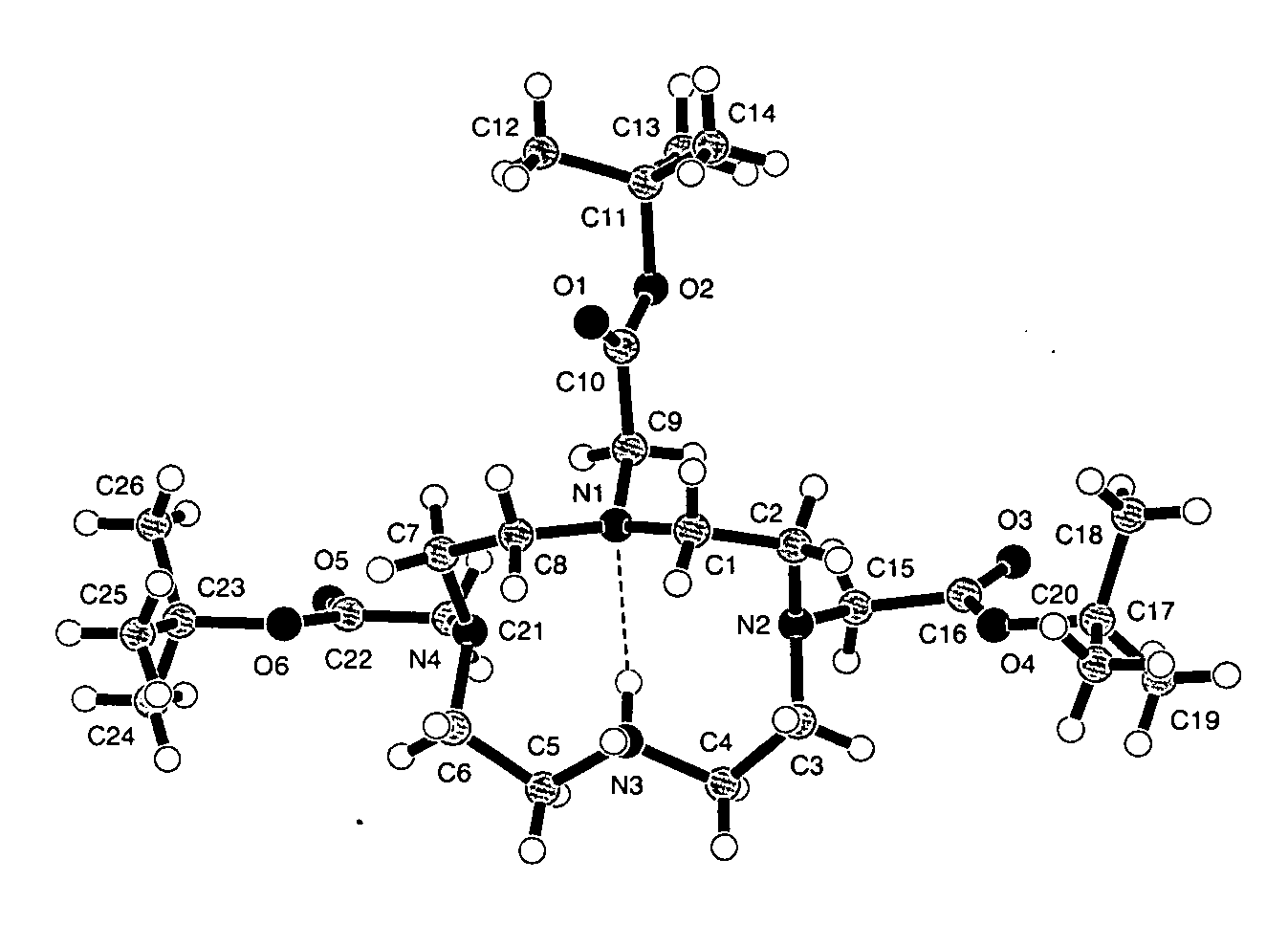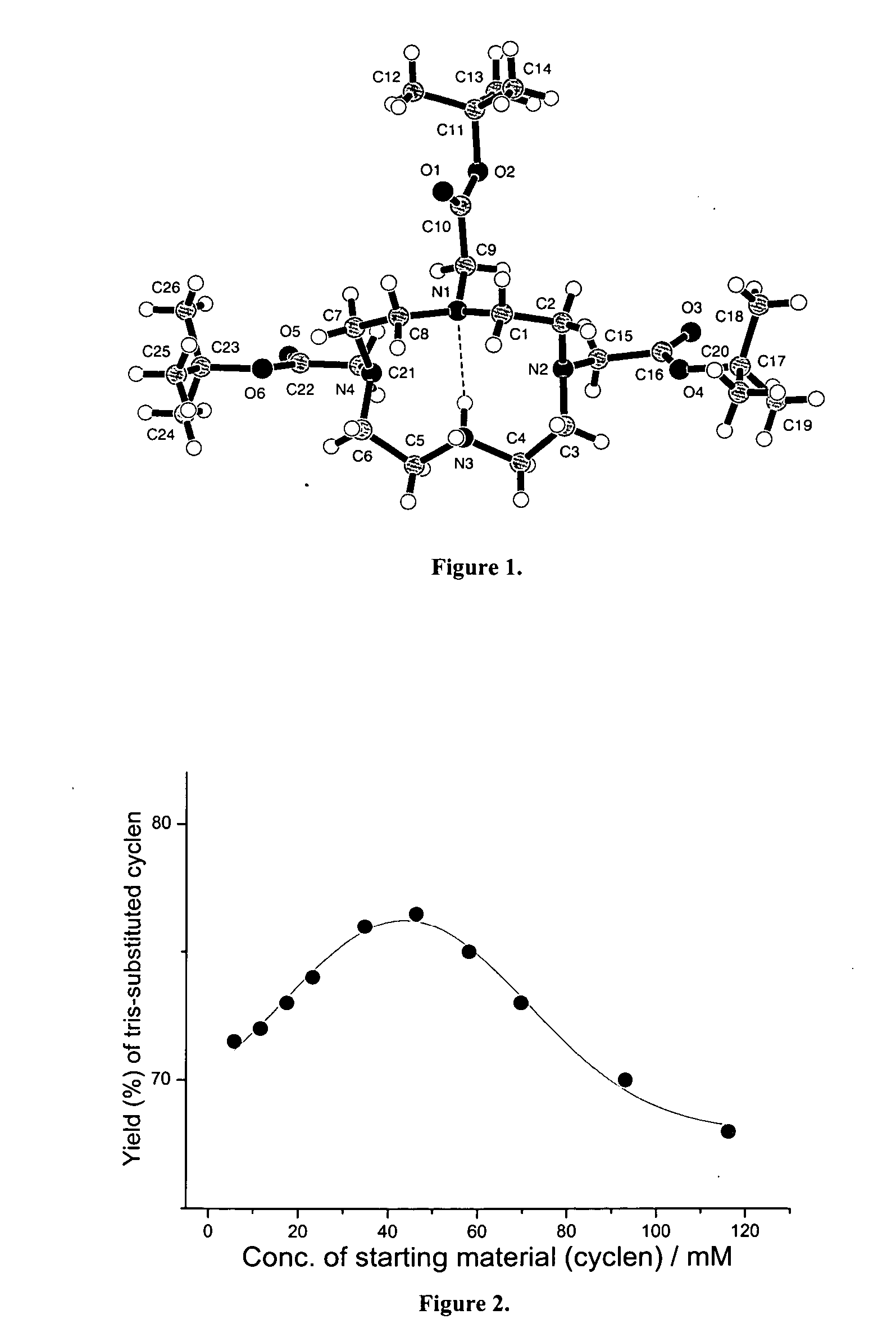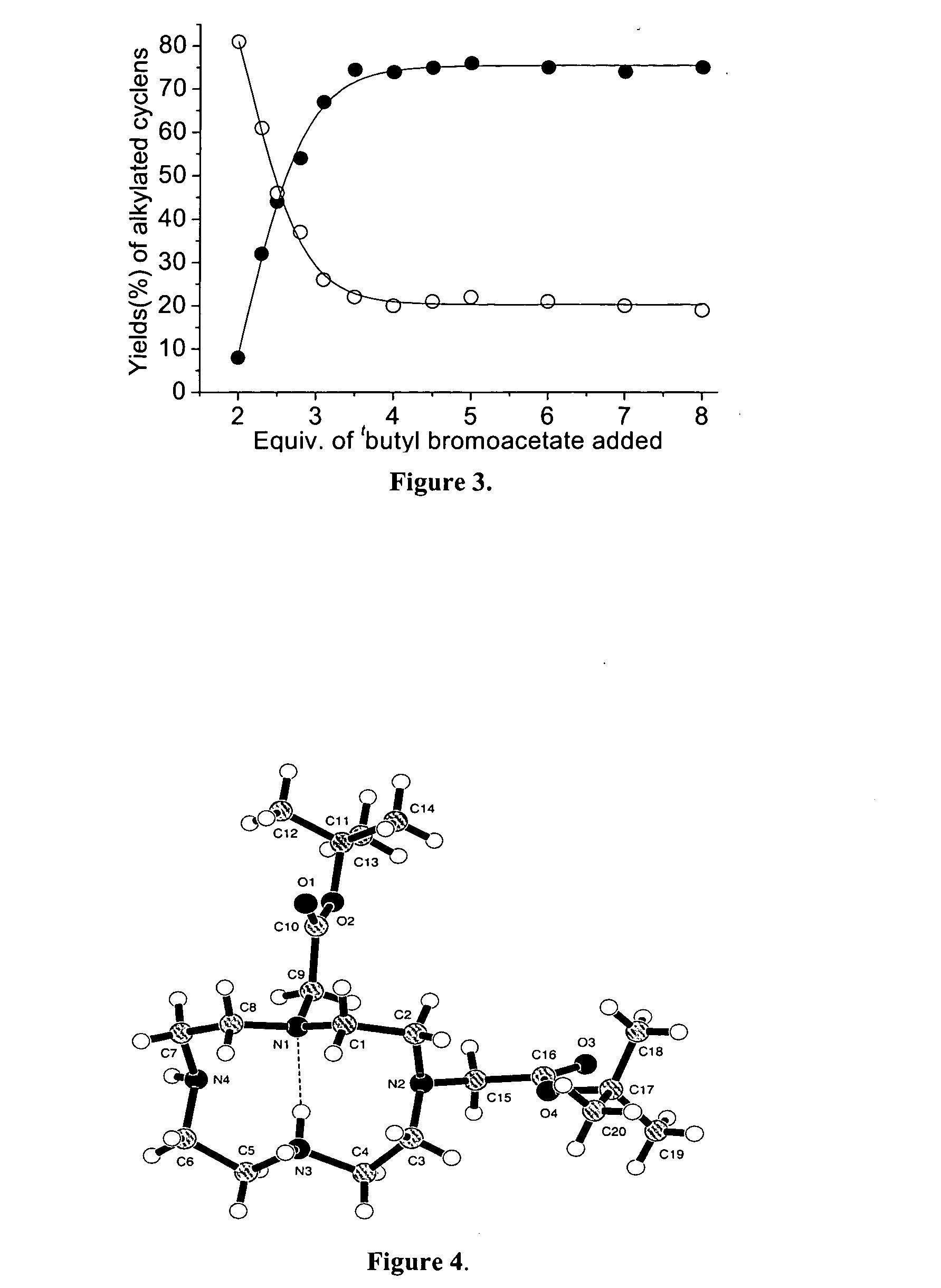Synthesis of tris N-alkylated 1,4,7,10-tetraazacyclododecanes
a technology of tetraazacyclododecane and tris nalkylated, which is applied in the field of magnetic resonance imaging, can solve the problems of high osmolality, inability to selectively polyalkylate cyclen, and well-known drawbacks of current clinical us
- Summary
- Abstract
- Description
- Claims
- Application Information
AI Technical Summary
Benefits of technology
Problems solved by technology
Method used
Image
Examples
example 1
Tris-(tert-butoxycarbonylmethyl)-1,4,7,10-tetraazacyclododecane (1)
3.3 equivalents of tert-butyl bromoacetate (773.0 mg, 7.6 mmol) dissolved in 10.0 mL anhydrous chloroform was added dropwise to a mixture of 1,4,7,10-tetraazacyclododecane (cyclen) (400.0 mg, 2.32 mmol) and 10.0 equivalents of triethylamine (2.3 g, 23.2 mmol) in 40 mL anhydrous chloroform under an argon atmosphere for about half an hour. The reaction mixture was stirred for another 2 hours, and 0.5 equivalents of anhydrous K2CO3 was added. After a further 14 hours of reaction, the resulting solution was washed by water (3×40 mL). Then anhydrous Na2SO4 was used to dry the organic phase and the solvent was removed under vacuum to give a transparent oil. This crude product was purified by flash chromatography on aluminium oxide (dichloromethane / methane=200:5 (volume / volume), Rf=0.35) to give tris-(tert-butoxycarbonylmethyl)-1,4,7,10-tetraazacyclododecane (1) as a white powder (0.92 g, 1.78 mmol), yield: 77%. mp 178-18...
example 2
Tris-[(diphenyl)methylcarbamoylmethyl]-1,4,7,10-tetraazacyclododecane (2)
3.3 equivalents of N-2-chloroethanoyl-diphenylmethylamine (1.98 g, 7.6 mmol) dissolved in 10.0 mL anhydrous chloroform was added dropwise to a mixture of 1,4,7,10-tetraazacyclododecane (cyclen) (400.0 mg, 2.32 mmol) and 10.0 equivalents of triethylamine (2.3 g, 23.2 mmol) in 40 mL anhydrous chloroform under an argon atmosphere for about half an hour. The reaction mixture was stirred for another 2 hours, and 0.5 equiv. of anhydrous K2CO3 was added. After a further 15 hours of reaction, the resulting solution was washed by water (3×40 mL) and the organic phase was dried by anhydrous Na2SO4. Removing the solvent under vacuum gave the light yellow solid. The crude product was purified by flash chromatography on aluminium oxide (dichloromethane / methane=200:10 (v / v), Rf=0.30) to give tris-[(diphenyl)methylcarbamoylmethyl]-1,4,7,10-tetraazacyclododecane as a colourless oil (1.58 g, 1.88 mmol), yield 81%. 1HNMR(400 M...
example 3
Tris-[(R)-1-(1-phenyl)ethylcarbamoylmethyl]-1,4,7,10-tetraazacyclododecane (3)
3.3 equivalents of (R)-N-2-chloroethanoyl-l-phenylethylamine (1.51 g, 7.6 mmol) dissolved in 10.0 mL anhydrous chloroform was added dropwise to a mixture of 1,4,7,10 tetraazacyclododecane (cyclen) (400.0 mg, 2.32 mmol) and 10.0 equivalents of triethylamine (2.3 g, 23.2 mmol) in 40 mL anhydrous chloroform under an argon atmosphere for about half an hour. The reaction mixture was stirred for another 2 hours, and 0.5 equivalents of anhydrous K2CO3 was added. After a further 14 hours of reaction, the resulting solution was washed by water (3×40 mL), after which the organic phase was dried by anhydrous Na2SO4 and the solvent was removed under vacuum to give a white solid. The crude product was purified by flash chromatography on aluminium oxide (dichloromethane / methane=200:12 (v / v), Rf=0.25) to give tris-[(R)-1-(1-phenyl)ethylcarbamoylmethyl]-1,4,7,10-tetraazacyclododecane as a colourless oil (1.08 g, 1.65 mm...
PUM
| Property | Measurement | Unit |
|---|---|---|
| Magnetic Resonance Imaging | aaaaa | aaaaa |
| MRI | aaaaa | aaaaa |
| internal structure | aaaaa | aaaaa |
Abstract
Description
Claims
Application Information
 Login to View More
Login to View More - R&D
- Intellectual Property
- Life Sciences
- Materials
- Tech Scout
- Unparalleled Data Quality
- Higher Quality Content
- 60% Fewer Hallucinations
Browse by: Latest US Patents, China's latest patents, Technical Efficacy Thesaurus, Application Domain, Technology Topic, Popular Technical Reports.
© 2025 PatSnap. All rights reserved.Legal|Privacy policy|Modern Slavery Act Transparency Statement|Sitemap|About US| Contact US: help@patsnap.com



